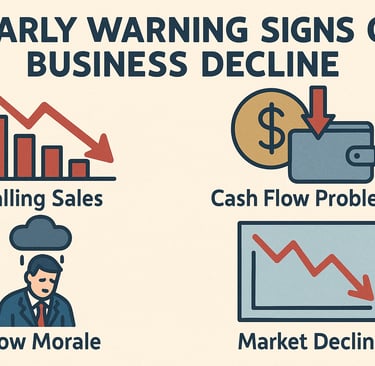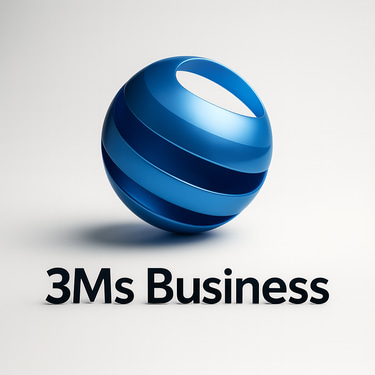Early Signs of Business Decline: What to Watch For
Early detection of business decline indicators—like falling sales, cash flow issues, customer loss, and operational inefficiencies—helps companies take timely action to prevent serious setbacks. Monitoring these warning signs enables proactive strategies that strengthen foundations, ensure stability, and support sustainable growth in a competitive market.
BUSINESS FAILURE DIAGNOSTICS
5/19/20255 min read


Recognizing the Early Warning Signs of Business Decline
Every business needs early detection systems for decline indicators to prevent severe consequences from occurring.
Running a successful business requires constant adjustment to changes in the environment. All companies regardless of their level of establishment face periods of decline despite their growth ambitions. Early detection of business decline indicators serves as a warning system which provides businesses with essential time to strengthen their foundations before major problems develop. Your business will remain on track when you remain attentive and take swift action against warning signs.
The following section explains major warning indicators which you should monitor along with their possible implications.
1. Declining Sales and Revenue
Business trouble becomes apparent when revenue and sales numbers demonstrate either a steady decline or rapid decrease. The market no longer shows interest in your products or services when they decline in popularity. Market competition advances when other businesses deliver superior value and innovation and create better customer experiences.
The reduction in sales leads to a diminishing market position because your current market segment shrinks. Raw sales numbers alone do not provide enough information so businesses need to monitor their long-term patterns. A persistent downward sales pattern demands urgent response while natural seasonal patterns do not.
The examination of sales data through product lines and regional and customer segment analysis helps businesses identify where their losses occur. The identification of these key areas allows organizations to create specific solutions through product enhancements and marketing adjustments as well as market exploration to generate new growth opportunities.
2. Deteriorating Cash Flow
A steady level of sales does not guarantee business health when cash flow problems exist in the background. The actual movement of funds through your company appears as cash flow which indicates liquidity issues when it shows negative or unstable patterns.
When customers extend payment periods and accounts receivable increase along with short-term borrowing needs your business demonstrates trouble meeting daily operational costs. When cash flow problems intensify they force businesses to delay vendor payments and reduce essential spending and accept costly debt obligations.
Your business needs to maintain a transparent understanding of its financial cash movements. Your business should use cash flow forecasting to predict upcoming shortages which enables you to develop strategies like better supplier payment terms and enhanced collection procedures.
3. Shrinking Profit Margins
The profit margin shows revenue minus costs as a percentage calculation of total revenue. Stable sales do not guarantee business stability because continuous profit margin reduction indicates potential underlying problems.
The increase in costs for raw materials together with labor expenses and rent and overhead costs creates a negative impact on your financial performance. Profits will decline if your business fails to raise prices to match rising operational expenses. The reduction in profit margins can result from operational inefficiencies as well as weak pricing approaches.
You can determine expense reduction opportunities through cost structure analysis which helps you renegotiate contracts and optimize pricing. Business profitability declines rapidly because of insufficient margin management responses even when revenue stays decent.
4. Losing Customers and Lower Retention Rates
Business sustainability depends heavily on customer loyalty and retention practices. Customer churn indicates a major warning sign when it increases because more customers choose to stop buying your products or services.
Customer satisfaction has decreased while competitors provide better alternatives and your brand has not adapted to changing customer preferences. A decrease in customer retention rates increases both revenue acquisition expenses and customer management expenses since retaining customers costs less than acquiring new ones.
Regular customer satisfaction surveys together with review monitoring and analysis of customer behavior data serve to detect factors leading to customer churn. The development of better customer engagement requires service improvements alongside loyalty programs and customized experiences.
5. High Employee Turnover and Eroding Morale
The departure of important personnel from a business and decreasing staff morale indicate substantial organizational problems which require immediate attention. Operations suffer disruptions when staff members leave and organizations lose their institutional knowledge while remaining employees become demoralized which worsens productivity issues.
The main reasons behind employee departure include poor leadership together with insufficient career advancement opportunities and insufficient compensation and an unacceptably toxic work environment. Low employee morale leads to disengagement which causes work quality to decrease and employees become absent more frequently.
Organizations must focus on employee feedback while conducting exit interviews to develop leadership and well-being programs which prevent these problems from worsening.
6. Increasing Debt and Financial Stress
A business facing financial instability will result from both rising debt accumulation and excessive dependence on external financing. Business operations normally involve some debt but increasing operational borrowing without a clear path to profitability presents substantial risks.
Uncontrolled debt creates higher interest expenses and reduced financial flexibility which could eventually result in business insolvency. The financial burden on leaders prevents them from focusing on strategic initiatives while causing stakeholders to lose confidence in the company.
Your business requires two key measures to maintain sound finances: evaluating debt structure and securing better loan terms and developing specific growth plans that match your borrowing needs.
7. Declining Brand Reputation and Customer Feedback
Brand reputation today faces immediate destruction or creation through digital channels which function at high speed. Your products or services face customer dissatisfaction when negative reviews and complaints along with social media backlash increase in number.
Online platforms quickly spread trust-damaging service failures and unresolved issues which lead to poor quality resulting in serious reputational damage. Negative customer sentiment creates two major challenges: it hurts existing sales performance and makes it harder to bring in new customers.
To reverse this trend you need to implement active reputation management through immediate feedback response and transparent issue resolution and enhanced product/service quality.
8. Failure to Innovate or Adapt
Markets evolve, technologies advance, and consumer behaviors shift. Failure to innovate and adapt to market changes will lead businesses to become outdated. The signs of stagnation in product lines alongside digital transformation neglect and reluctance to enter new markets indicate the company's failure.
An organization which discourages both creativity and risk-taking will block its growth potential while making itself susceptible to more agile competitors. Businesses need continuous innovation through product development and business model changes and customer engagement improvements to remain relevant in the market.
9. Operational Inefficiencies
The presence of operational inefficiencies shows itself through accumulating unsold inventory and production delays and excessive waste and poor supply chain management. The inefficiencies create higher operational costs while simultaneously damaging customer satisfaction and weakening brand reliability.
Customer trust decreases when delivery times become longer while holding excess inventory blocks essential working capital. The mentioned symptoms typically point toward outdated systems and misaligned processes which require modernization.
Taking Action: The Importance of Continuous Monitoring and Early Intervention
Every warning sign presents an opportunity to pause operations and assess the health of your business. Businesses need to develop strong systems for ongoing monitoring through scheduled financial checks and employee opinion polls and customer feedback collection and market trend assessments.
A business operates like a biological system which needs scheduled evaluations to stay healthy. Identifying small imbalances during their early stages allows businesses to resolve problems with little impact on operations while ignoring symptoms leads to serious crises.
You must take immediate action if any of these warning signs match what you are facing in the present. A thorough review of your business approach combined with operational simplification and innovation funding or expert consultation will help your company recover from decline toward future success.
Conclusion
The process of business decline takes time to develop instead of occurring suddenly. Businesses show warning signs at first which become detectable when handled properly before a successful intervention and transformation becomes possible. Your business will take action before problems arise when you monitor declining sales and cash flow issues and shrinking profits and customer loss and employee turnover and financial stress and reputational damage and lack of innovation and operational inefficiencies.
The time between a short-term setback and complete organizational crisis depends mainly on how well you detect problems and execute swift responses. Your business future becomes secure while sustainable growth becomes possible when you build a strong foundation before the earthquake starts.
Consulting
Empowering businesses through strategic consulting solutions.
Growth
Success
+966553997996
© 2025. All rights reserved.
